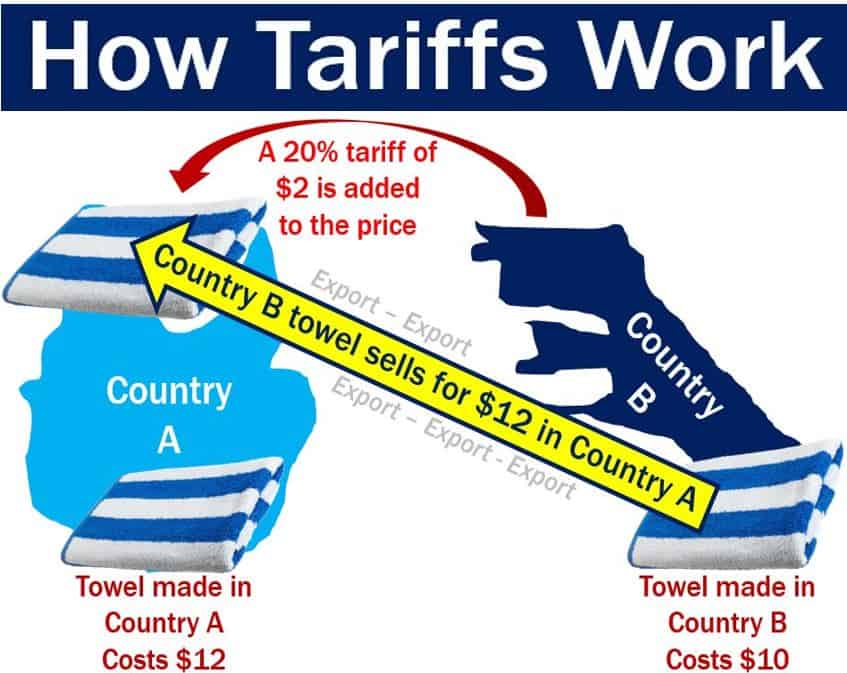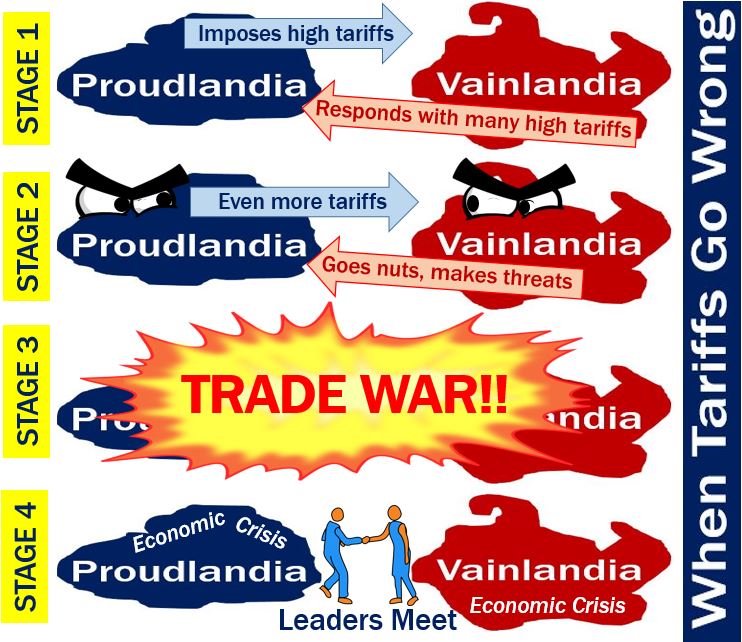What are tariffs? Definition and meaning
Tariffs are customs duties or taxes imposed on goods that are imported. Their purpose is to either elevate the cost of these imported products to match or exceed local market prices, or to generate government revenue.
Tariffs along with quotas – limiting the quantity of imports coming into a country – are two weapons that countries use to both protect their domestic producers and improve their trade balance.
The strategic use of tariffs can serve to incentivize local production and foster the growth of nascent industries within a nation.
Tariffs may also be applied to exported goods. Some countries tax grain exports in order to prevent a shortage at home.
Barrier to trade
Tariffs are one of the most pervasive and oldest forms of trade protection, often described as a barrier to trade.
According to the World Trade Organization (WTO):
“Customs duties on merchandise imports are called tariffs. Tariffs give a price advantage to locally-produced goods over similar goods which are imported, and they raise revenues for governments. One result of the Uruguay Round was countries’ commitments to cut tariffs and to “bind” their customs duty rates to levels which are difficult to raise.”
“The current negotiations under the Doha Agenda continue efforts in that direction in agriculture and non-agricultural market access.”
The World Trade Organization is a forum where its more than 165 member states solve their international trade disputes. It lays down the rules and regulations for trading between nations.

Types of tariffs
There are five main types of tariffs, protective, prohibitive, specific, ad valorem, and revenue:
-
Protective Tariff
Used to push up the price of imported products as a protective measure against foreign competition, i.e. the purpose is to help domestic suppliers compete more effectively in the home market.
-
Prohibitive Tariff
The tax is so high that it makes an import far too (prohibitively) expensive. The aim here is to completely discourage importers from bringing the product into the country, because they would find it impossible to sell.
-
Ad Valorem
The tax applies to a percentage of the imported good’s value. For example, an ad valorem of 10% would mean that a product costing $100 would sell in the market of the importing country for $110.
-
Specific Tariff
Rather than taxing according to the product’s value, the tax is based on the specific amount – which could be the good’s weight, number, or other measurement.
- Revenue Tariff
This tax is imposed mainly to raise government income rather than to protect domestic producers. For example, if Canada, Sweden or Finland imposes tariffs on imported mangoes, the purpose is not to protect domestic mango farmers – there aren’t any. The mango tariff is purely to raise revenue for the government.

Tariffs as economic sanctions
Tariffs may be employed as part of economic sanctions if one country or a group of allies try to compel another country to change its policy.
Economic sanctions are restrictions that a country or group of countries establish to influence political or economic change by reducing trade, investment, or imposing tariffs.
Etymology of tariffs
Etymology is the study of the origin and evolution of the meanings of words. An etymology specialist is called an etymologist.
According to the Online Etymology Dictionary, the noun Tariff appeared in the English language in Britain in the 1590s, with the meaning “arithmetical table” and “official list of customs duties on imports or exports; law regulating import duties”, which came from the Italian word Tariffa meaning “assessment, tariff, price.”
The Medieval Latin word Tarifa meant “book of rates, list of prices” – it came from the Arabic Ta’rif”, meaning “notification, information, a making known; inventory of fees to be paid.”
Some people credit the small Spanish town of Tarifa in Andalusia as being the origin of the term ‘Tariff’ in English. It was the first port in Europe to charge merchants for the use of its docks.
Duty-free goods
In most countries, international travelers are allowed to bring goods into the country duty-free – free of tariffs. These products are bought at airports, ports or in a country where those goods are tax-free, and then brought into another country duty-free.
There is usually an allowance which limits how much – in numbers, weight or value – of duty-free goods a traveler can bring into the country.
These limits are typically applied to wine, spirits, tobacco, cosmetics, souvenirs, and gifts. Diplomats and UN officials are entitled to carry duty-free goods without any limits.
Tariffs – pros and cons
In most of the advanced economies, policy makers go back and forth on whether tariffs are a good or bad thing. When a domestic sector feels threatened by foreign competition, or unfair practices abroad, it will ask lawmakers to impose tariffs on certain imports.
In the short-term, tariffs help specific industries, which generally create more jobs or protect the ones that currently exist.
However, tariffs also raise the prices of imported goods, which is not good for consumers. There is always a trade-off between industry and employees versus consumers as far as tariffs are concerned.
Tariffs also carry risks – other countries may retaliate and trade wars could ensue. Trade wars are bad for everybody’s economy.
Countries that import and export lots of goods and services are considerably wealthier than protectionist nations.
According to the Economist’s glossary of terms:
“Many countries have reduced tariffs as part of the process of freeing up world trade.”
Modern digital marketplaces and e-commerce platforms are influencing the application of tariffs as governments seek to regulate international online transactions.
In some regions of the world, countries get together and form customs unions. The EU Customs Union is the world’s largest. Member states can trade freely with each other with no tariffs or quotas.
Two Educational Videos
These two interesting video presentations, from our sister YouTube channel – Marketing Business Network, explain what ‘Tariffs’ and ‘Taxes’ are using simple, straightforward, and easy-to-understand language and examples.
-
What are Tariffs?
-
What is Tax?

